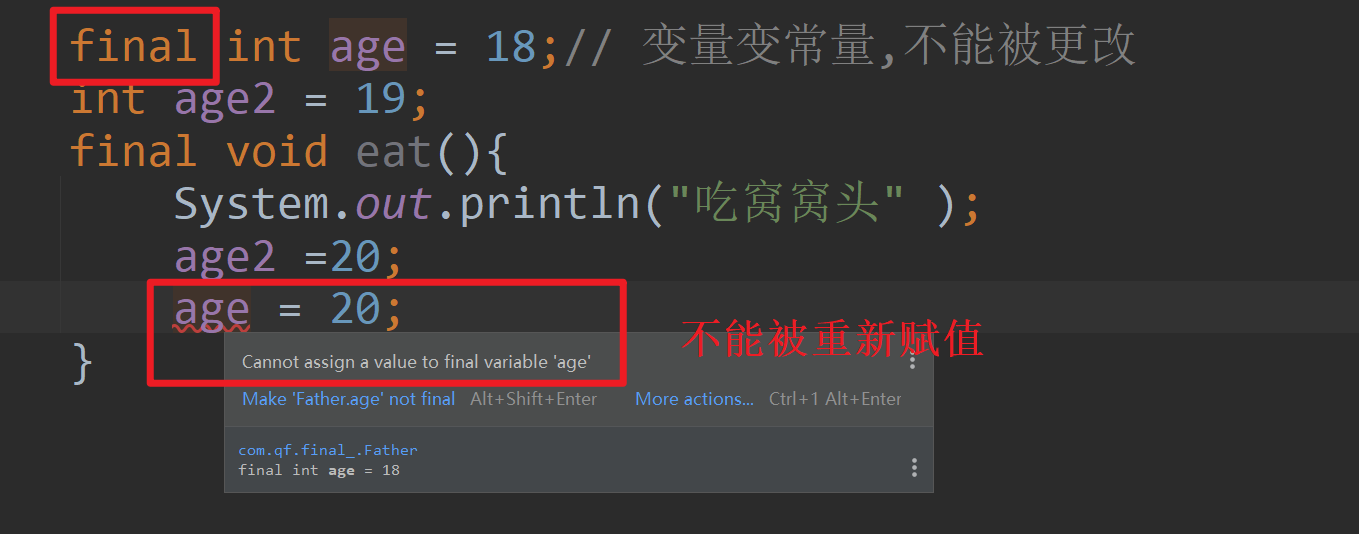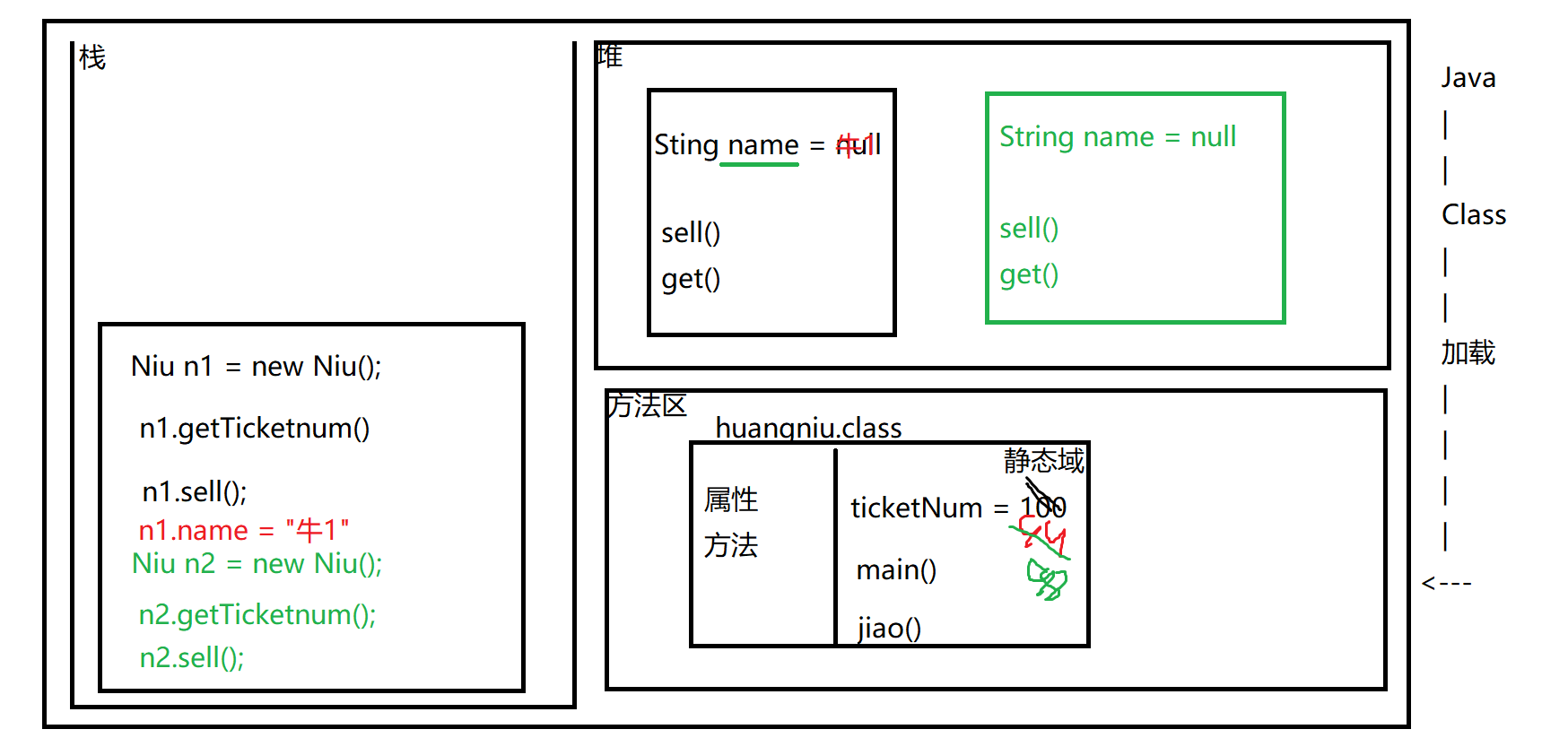今日内容
零、 复习昨日
一、final
二、static
三、多态
四、向上转型&向下转型
五、多态应用
零、 复习昨日
- 封装
- 类的封装: 1 属性私有 2提供setget
- 继承
- A extends B
- 子类可以使用父类非私有属性和方法
- 好处: 复用,多态准备
- 重写/覆写/覆盖/Override
- 子类重写父类的方法,以适应自己本身
- 多态准备
- this super
- 发现: 在创建子类对象时先创建父类对象
- 为什么? 默认构造方法第一行有个super()调用父类构造方法
- super代表父类对象 this 当前对象
- super() super(实参) super.属性 super.方法
- this() this(实参) this.属性 this.方法
- 访问修饰符
- public > protected > package > private
- 子父类创建对象的过程
- new 子类(),但是先super()调用父类构造
- 父类属性先初始化,后再执行父类构造方法内代码
- 在子类属性初始化,最后执行子类构造方法内代码
- 将对象地址赋值给引用
一、final
final 最终最后,修饰符,用来修饰类,属性,方法
final 修饰类,该类不能被继承,即该类不能有子类 (太监类)

final 修饰方法,该方法不能被重写

final 修饰属性/变量,变量变常量,不能被更改

final int PEOPLE_AGE = 19;
/**
* 命名规范:
* 变量命名驼峰原则: userName
* 常量命名: 全部大写,多个单词之间使用下划线
*/
public static void main(String[] args) {
// final 限制了father引用不能再改变
final Father father = new Father( );
// 但是不影响对象内部属性的变化
father.age2 = 19;
// 即不能像这样,再次引用别的对象
// father = new Father();
}
二、static
2.1 特点
static 静态修饰符,修饰属性 ,方法 ,类(静态内部类)
package com.qf.static_;
/**
* --- 天道酬勤 ---
*
* @author QiuShiju
* @desc
*/
public class Huangniu {
/**
* static 修饰的属性在内存只有一份,被该类所有对象共享
* 即这些静态属性叫做: 类属性,属于类
* --------------------------------------
* - static修饰属性和方法,随着类(字节码文件)加载而初始化
* - static修饰的属性和方法,可以直接通过类名调用,不用对象
* - static修饰的属性和方法,在内存只有一份,不属于某个对象,而是属于字节码文件
*/
static int ticketNum = 100;// 许嵩演唱会票
/**
* 普通成员变量,即成员属性,每次创建对象,每个对象都有一份属于自己的属性
* 即这些属性叫做: 对象属性,这些属性属于对象
*/
String name;
// 售票
public void sell(){
ticketNum--;
System.out.println("售出一张" );
}
// 查余票
public int getTicketNum(){
return ticketNum;
}
public static void jiao(){
System.out.println("黄牛叫卖" );
}
public static void main(String[] args) {
Huangniu niu1 = new Huangniu( );// 黄牛
System.out.println("1售票前"+niu1.getTicketNum( ));
niu1.sell();// 售票
System.out.println("1售票后"+niu1.getTicketNum( ));
niu1.name = "牛1";
System.out.println("----------" );
Huangniu niu2 = new Huangniu( );// 黄牛
System.out.println("2售票前"+niu2.getTicketNum( ));
niu2.sell();// 售票
System.out.println("2售票后"+niu2.getTicketNum( ));
System.out.println(niu2.name );
System.out.println(Huangniu.ticketNum );
Huangniu huangniu = new Huangniu( );
}
}

总结:
- static修饰属性和方法,随着类(字节码文件)加载而初始化
- static修饰的属性和方法,可以直接通过类名调用,不用对象
- static修饰的属性和方法,在内存只有一份,不属于某个对象,而是属于字节码文件
- 静态方法只能调用静态
- 静态方法内部不能使用this
2.2 应用
1 当某些数据需要被所有对象
共享时,给数据(属性或变量)设置static,例如票
2 当某些方法需要
方便调用时,可以将方法设置静态,这样就是通过类名直接调用,而不用创建对象
int[] arr = {1,23,4,5,6};
System.out.println(Arrays.toString( arr) );
System.out.println(Math.abs(-1));
总结: 有静态修饰就直接使用,没有静态修饰,就创建对象用对象调用
三、多态
生活中的多态: 变形金刚,蝌蚪,铁甲小宝
程序中的多态: 同一个方法,出现不同的结果
多态的出现,要满足三个前提条件:
- 继承/实现
- 重写
- 父类引用指向子类对象(向上转型)
演示
package com.qf.poly;
/**
* --- 天道酬勤 ---
*
* @author QiuShiju
* @desc
*/
public class TestPoly {
public static void main(String[] args) {
// 创建对象
// 类名 对象名 = new 类名();
// 类名 引用 = new 构造方法();
Dog dog = new Dog();
// 父类引用,指向子类对象(向上转型)
// Animal animal = new Dog();
//
// animal.eat();
feed(new Dog( ));
feed(new Cat( ));
feed(new Pig( ));
feed(new Tiger( ));
}
// 多态改造
// Animal animal = new Dog( );
// Animal animal = new Cat( );
// Animal animal = new Pig( );
// Animal animal = new Tiger( );
public static void feed(Animal animal) {
animal.eat();// 此方法体现出多态效果
/**
* 编译看父类
* 运行看子类
*/
}
// 动物园饲养动物
// public static void feed(Dog dog){// Dog dog = new Dog
// dog.eat();
// }
//
// public static void feed(Cat cat) {
// cat.eat();
// }
// public static void feed(Pig pig) {
// pig.eat();
// }
}
多态应用场景:
- 方法的参数列表是父类引用
- 定义一个父类类型数组,存储所有动物,创建Animal[]
多态的好处:
- 扩展性
- 解耦合/松耦合
- 开发原则: 高内聚 低耦合
{
// cat.eat();
// }
// public static void feed(Pig pig) {
// pig.eat();
// }
}























 1536
1536











 被折叠的 条评论
为什么被折叠?
被折叠的 条评论
为什么被折叠?








